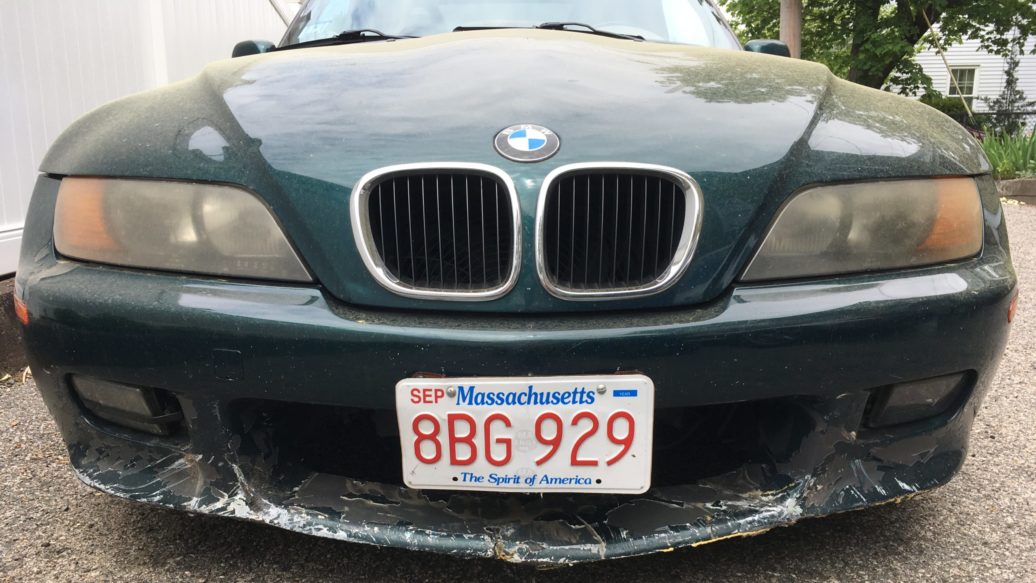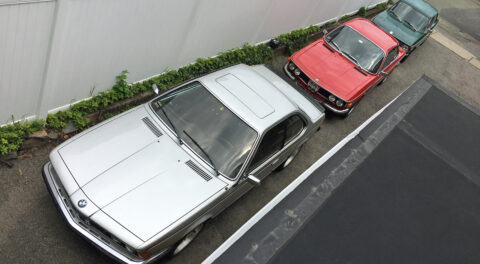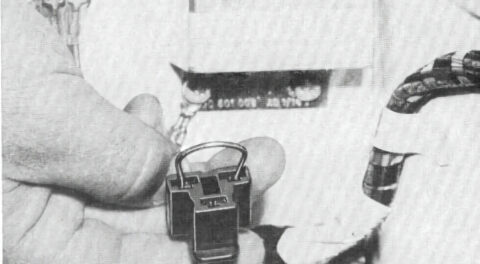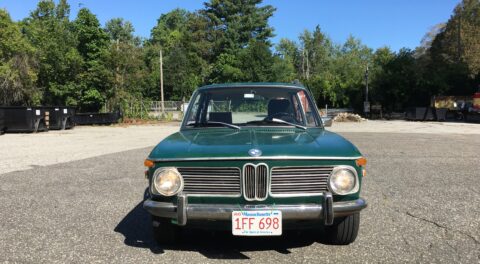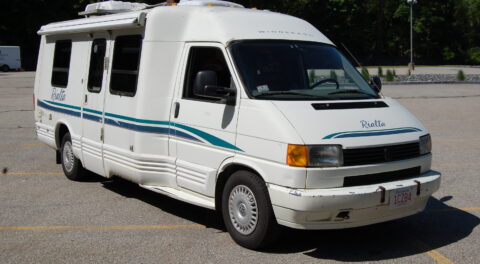As many of you know, last year I bought back Zelda, the 1999 Z3 2.3i that I’d sold to my friend and neighbor Kim a few years back. The car needed a ton of work, as the clutch-release bearing had self-destructed, and then Kim’s son had put the car up on a median strip. This shattered an already damaged front bumper cover and bent the lower control arms and all four wheels.
Buying it back was partly an emotional decision, as the car has a circle of followers (“the Cult of Zelda”) and certainly would’ve been totaled and parted out otherwise. But logic factored in as well; I figured that as long as nothing else big was bent or broken, I could come out of it with not only a usable Z3, but one that I actually had an emotional attachment to—for less than I’d pay for any other running roadster.
Last fall I replaced the bent steering components, and then over the winter I attacked the clutch. The latter was a truly miserable job, but once it was done and spring arrived, I felt like I’d hit the jackpot; my old Z3 friend was back, and for stress reduction, nothing beats dropping the top in a fun little two-seater.
The main remaining issue was the mangled front bumper cover (what most people would call the air dam, except it’s no longer a separate part, and instead is part of a big plastic facia piece that covers most of the front of the car below the hood line). Even before striking the curb surrounding the median strip, the bumper cover was in rough shape, clearly having been damaged, Bondoed, and repainted before. In its most recent encounter, it got cracked clean through in three places, and also lost about two thirds of the lower stiffening piece, so it had the rigidity of overcooked asparagus.
A few well-placed wraps of packing tape prevented it from dragging on the ground and allowed me to drive the car. Early in the spring, I spent a few evenings attempting to fix the cracks with two-part epoxy and a variety of clamps, but like the old man in A Christmas Story trying to fix his leg lamp (“Get… the glue”), the repair didn’t hold, and I had to go back to using packing tape.
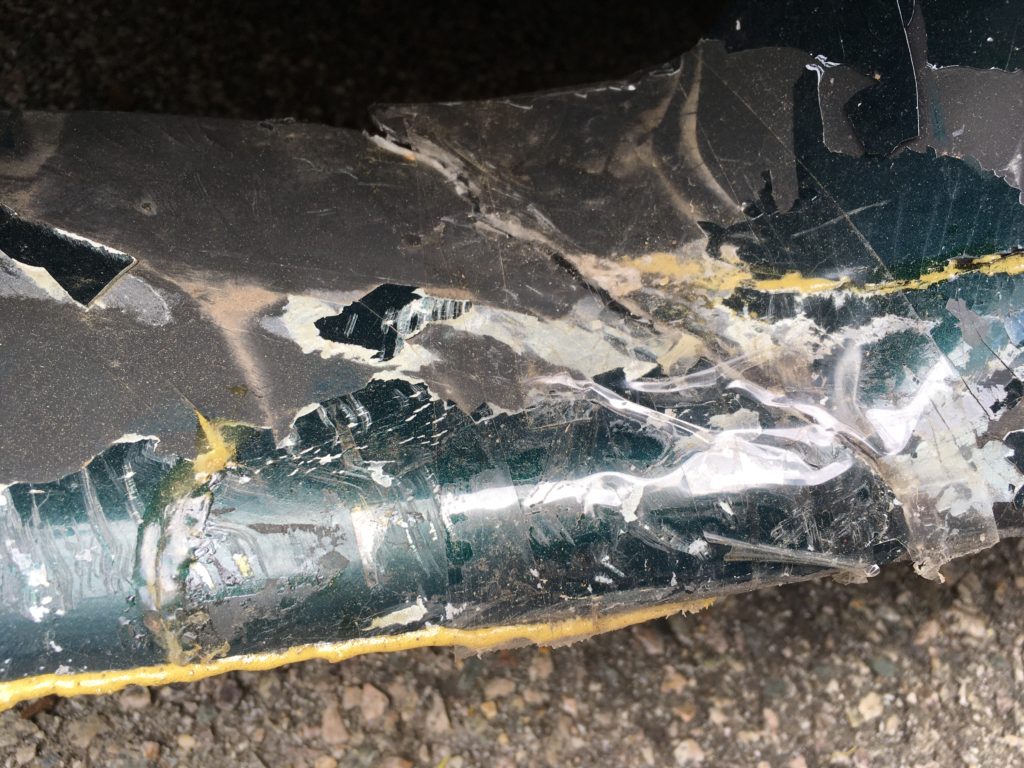
One of the cracks barely held in place with packing tape after my failed repair. The line of Gorilla Glue holding what was left of the stiffener is visible at the bottom. You also can see how the curb strike flexed the air dam, which made it shed much of a previous bad Bondo-and-paint repair.
Although I’m someone who prizes functionality far more than appearance, and while Zelda was fully functional and providing me with needed relaxation and joy, the more I drove the car during the spring, the more the bumper cover bugged me. There were three separate reasons: The first was that the sagging lower part of the cover (the “front spoiler” part) would scrape easily on driveways. The second was that on turning right, I was hearing the wheel scraping on something; it was coming not from the bumper cover, but from the fender liners, which were also shattered in the curb strike, and whose replacement I thus considered part of the same repair.
But the third was that the rest of Zelda actually looks fairly presentable, and making the car look whole would, in fact, give me satisfaction. Shocking, I know.
But, like anything I do, it had to come at the right price.
In my mind, I set a threshold of “I’d do it for $300,” but that turned out to be virtually unachievable. The fender liners are cheap—aftermarket ones are only about $40 a side—but the list price of a new OEM front bumper cover (part number 51110307536) is $792.62. And because of its size, shipping one is quoted as freight (e.g., strapped to a pallet).
Obviously, a used bumper cover could be found cheaper than a new one, but whether new or used, I’d need to get it painted Boston Green to match the car, and painting was probably a bare minimum of $100 for two rattle cans of color and one of clear. I kept hoping that I could shove both birds and one stone through the eye of the needle and find a used Boston Green bumper cover for sale locally, but despite vulturing for one all winter, the only one I found was on eBay in Florida, advertised for $255, plus an additional $250 to ship. And with all that expense, it had visible damage.
Then I noticed that some of the aftermarket bumper covers available on eBay and Amazon were not only surprisingly inexpensive (like $220), but also had free shipping. How, I wondered, could they do that when people selling new and used ones were quoting hundreds of dollars in freight costs to ship? But when one vendor on Amazon dropped his price from $220 to $180 in order to clear out his last three bumper covers, and I saw that the description said it came already primed, I didn’t ask questions; I just clicked and bought.
With the replacement on the way, I needed to line up my ducks with regard to painting. While I have a compressor, I’ve never used it to paint anything; the closest I came was spraying dye when I redid the sport seats in my E30 four years back. And I’ve only used rattle cans to do small things like mirror housings. I’m well aware that high-quality results require high-quality preparation and attention to detail, and generally I don’t have that kind of patience. However, seeing the photos above, I’m sure that you can appreciate my view that the paint job would look better than what was currently on the car.
So I put out the question on Facebook. I posted, “I need advice from the brain trust. I just ordered a $180 aftermarket front bumper cover (e.g., front facia and air dam) to replace the one on Zelda that got smashed and trashed in the curb strike last fall. It needs to be painted. I DO have a compressor, but I’ve never used it to paint anything. What do you think: Just buy three cans of Boston Green spray paint and rattle-can it, or buy a cheap spray gun (and regulator and moisture separator) and use my compressor? This is NOT a mint car by any stretch of the imagination; the result just needs to look no worse than the rest of the car. And I can’t spray in my garage, so anything I spray will need to be in my back yard. The bumper cover reportedly comes already primed.”
I got 115 responses.
They were incredibly informative, but there was absolutely no consensus; they were about equally split between “Just rattle-can it” (with sub-groups recommending SprayMax 2K paint or having spray bombs custom-made by a real local automotive paint shop), “Just buy a high-pressure low-volume (HPLV) paint gun for your compressor and shoot it yourself,” and “You’re an idiot if you think you can shoot it in pollen season and get decent results; just suck it up and pay the money to have it professionally done.”
I then had some fun with my readership, put up another post razzing them as useless for their lack of consensus, and got another 116 comments, including some from an emerging splinter cell who recommended wrapping or dipping it.
Fun aside, the crowd-sourcing was useful. A subset of the “Have it done professionally” approach was “Just load it in the back of a car, drive it to Maaco, and offer them a hundred bucks. Worked for me.” That began to sound very appealing—until the guy who said he’d paid a hundred bucks to get his done admitted that the body shop was owned by a family member.
But then a friend of my wife’s offered that her husband, a Porsche guy who does run a body shop, would shoot it for me for a hundred bucks.
Ducks lined up. Let’s start shooting.
A few days later, when I was in the garage, Maire Anne texted me, “There’s a really big box on the front stairs for you.” I went out to embrace my bumper-cover-related fate. The box was big, but not close to the enormous size I pictured as necessary to hold the bumper cover that everyone said needed to be shipped on a pallet. I girded my loins to drag it into the garage, but found that it hardly weighed anything. I easily hoisted it up and carried it inside.

Big, but by no means pallet-worthy.
I carefully opened the top flaps and looked inside. The box was half empty, with what looked like a bag of something at the bottom. It didn’t make any sense.
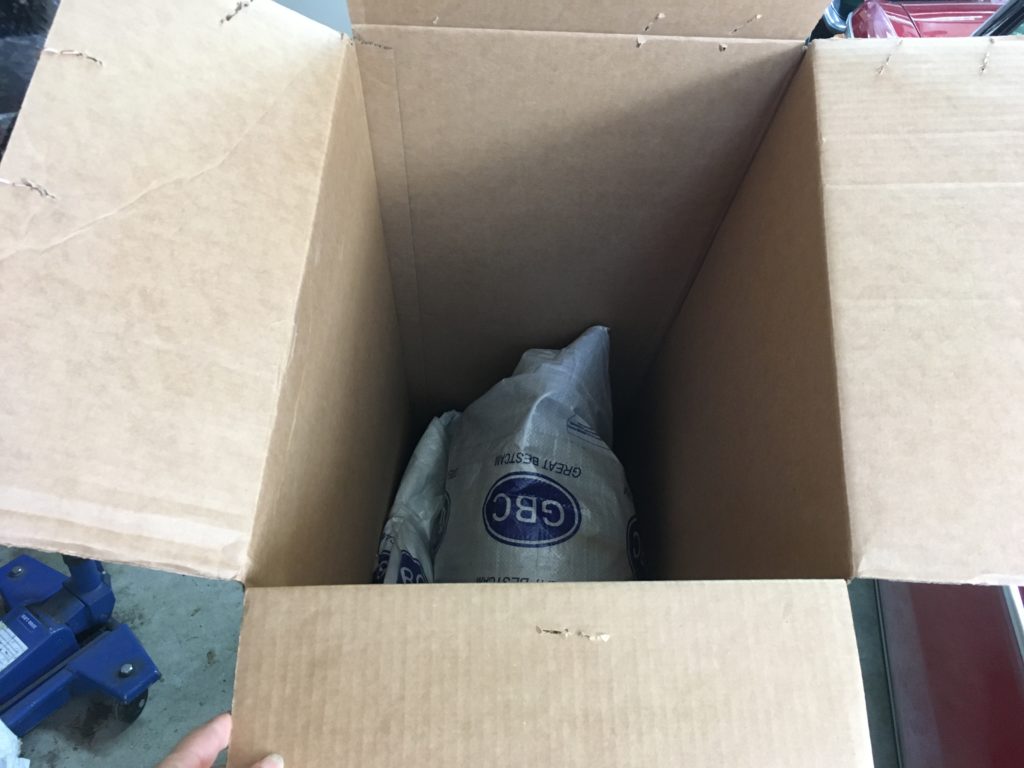
What the—?
I dumped it out on the garage floor, looked at the highly-non-bumper-cover-looking object, and had a genuine conceptual disconnect. How could the contents of this band-strapped bag be a bumper cover?

What did I just buy? Is this an inflatable bumper cover? Well, close.
And then I realized: This thing is so thin that it’s folded. In thirds. It’s not even remotely close to the thickness and weight of the original bumper cover. Looking at it, I imagined that the fold marks would probably never come out and it would probably never look right. Hell, it might even flap just as badly as my original one that’s held together with packing tape. Suddenly the idea that the $180 bumper cover shot with even one $30 rattle can would have to be better than what was on the car was in doubt. For a final laugh, check out the lower right corner of the label: Primed indeed.
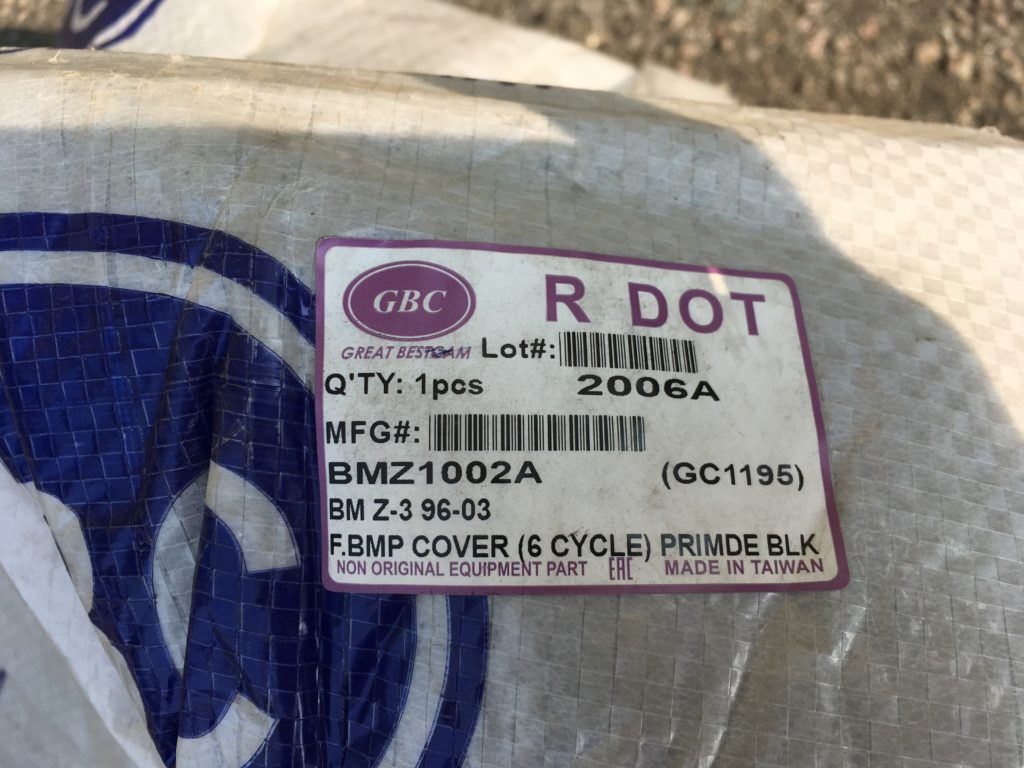
It’s not “primed.” It’s “primde.” Presumably with pride.
Okay. One more. Everyone channel Ed McMahon. HOW THIN AND LIGHT WAS IT? It was so thin and light that I could lift it up with my pinkie.
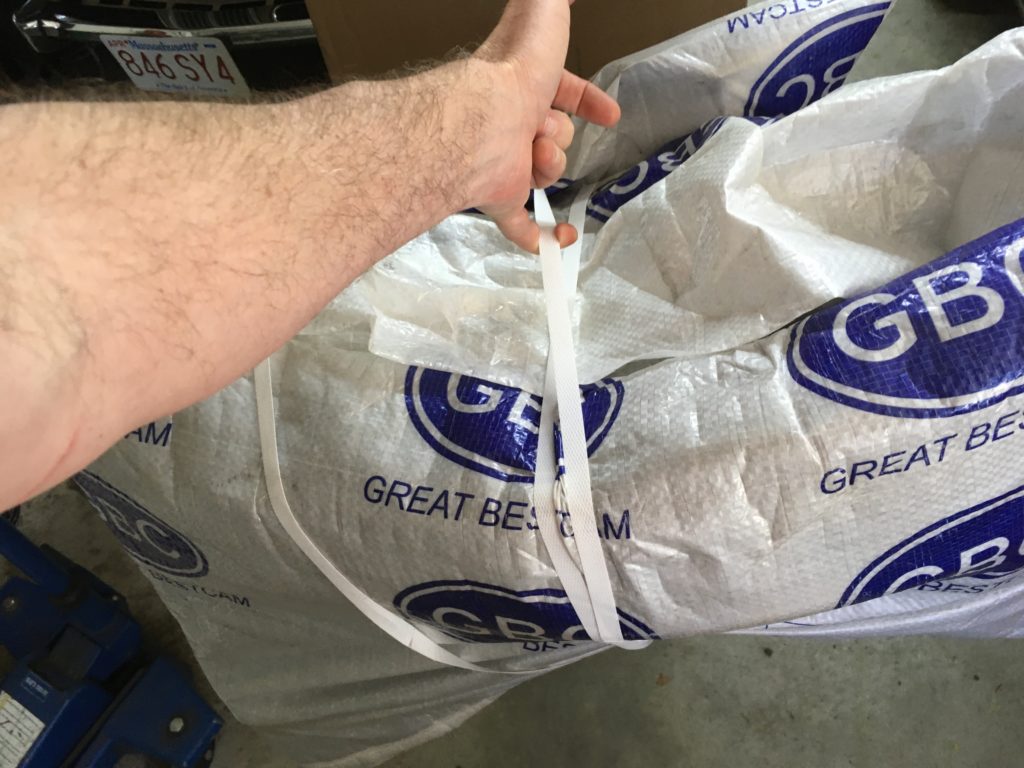
Totally not kidding about the pinkie.
I jumped on Amazon and hit the “return” button, selecting “Product does not meet expectations” as the reason. Truer words have rarely been spoken.
So, ixnay on the $180 umper-cover-bay for Zelda. I have a pretty high tolerance for aftermarket parts that don’t affect performance or reliability, but this one tripped the ick alarm something fierce. I’ll probably keep my eyes open for an inexpensive used genuine cover close to home, and when I find it, use the wife’s friend’s husband’s body shop free-spin card that I seem to have been given.
In the meantime, that scraping sound you hear on driveways and right turns is probably me. To be certain, when you hear it, check for a smiling idiot in a Boston Green Z3 that is giving him pleasure despite the front spoiler looking like it lost a fight with a garbage disposal.—Rob Siegel
Signed inscribed copies of Rob’s new book, The Best Of The Hack Mechanic: 35 years of hacks, kluges, and assorted automotive mayhem from Roundel magazine, are now available for pre-order here and will be available on Amazon by the end of the month. His seven other books are all available on Amazon, and signed copies can be ordered directly from Rob here.

